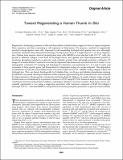Toward Regenerating a Human Thumb In Situ
Author(s)
Weinand, Christian; Gupta, Rajiv; Weinberg, Eli J.; Madisch, Ijad; Neville, Craig M.; Jupiter, Jesse B.; Vacanti, Joseph P.; ... Show more Show less
DownloadWeinand-2009-Toward Regenerating.pdf (474.5Kb)
PUBLISHER_POLICY
Publisher Policy
Article is made available in accordance with the publisher's policy and may be subject to US copyright law. Please refer to the publisher's site for terms of use.
Terms of use
Metadata
Show full item recordAbstract
Regenerative technology promises to alleviate the problem of limited donor supply for bone or organ transplants.
Most expensive and time consuming is cell expansion in laboratories. We propose a method of magnetically
enriched osteoprogenitor stem cells, dispersed in self-assembling hydrogels and applied onto new ultra-highresolution,
jet-based, three-dimensional printing of living human bone in a single-step for in situ bone regeneration.
Human bone marrow–derived mesenchymal stem cells (hBMSCs) were enriched with CD 117+ cells, dispersed
in different collagen I and RAD 16I hydrogel mixes, and applied onto three-dimensional printed b-tricalcium [beta tricalcium]
phosphate/poly(lactic-co-glycolic acid) scaffolds, printed from ultra-high-resolution volumetric CT
images of a human thumb. Constructs were directly implanted subcutaneously into nude mice for 6 weeks. In vivo
radiographic volumetric CT scanning and histological evaluations were performed at 1, 2, 4, and 6 weeks, and
expression of bone-specific genes and biomechanical compression testing at 6 weeks endpoint. Time-dependant
accumulation of bone-like extracellular matrix was most evident in CD 117+ hBMSCs using collagen I=RAD 16I
hydrogel mix. This was shown histologically by Toluidine blue, von Kossa, and alkaline phosphatase staining,
paralleled by increased radiological densities within implants approximating that of human bone, and confirmed
by high expression of bone-specific osteonectin and biomechanical stiffness at 6 weeks. Human origin of newly
formed tissue was established by expression of human GAPDH using RT-PCR. Statistical analysis confirmed high
correlations between biomechanical stiffness, radiological densities, and bone markers. Bone tissue can be successfully
regenerated in vivo using a single-step procedure with constructs composed of RAD 16I=collagen I
hydrogel, CD 117+–enriched hBMSCs, and porous b-tricalcium [beta tricalcium] phosphate/poly(lactic-co-glycolic acid) scaffolds.
Date issued
2009-03Department
Massachusetts Institute of Technology. Department of Mechanical EngineeringJournal
Tissue Engineering. Part A
Publisher
Mary Ann Liebert
Citation
Weinand, Christian et al. “Toward Regenerating a Human Thumb
In Situ.” Tissue Engineering Part A 15.9 (2009) : 2605-2615. 14 June 2011.
Version: Final published version
ISSN
1937-3341
1937-335X